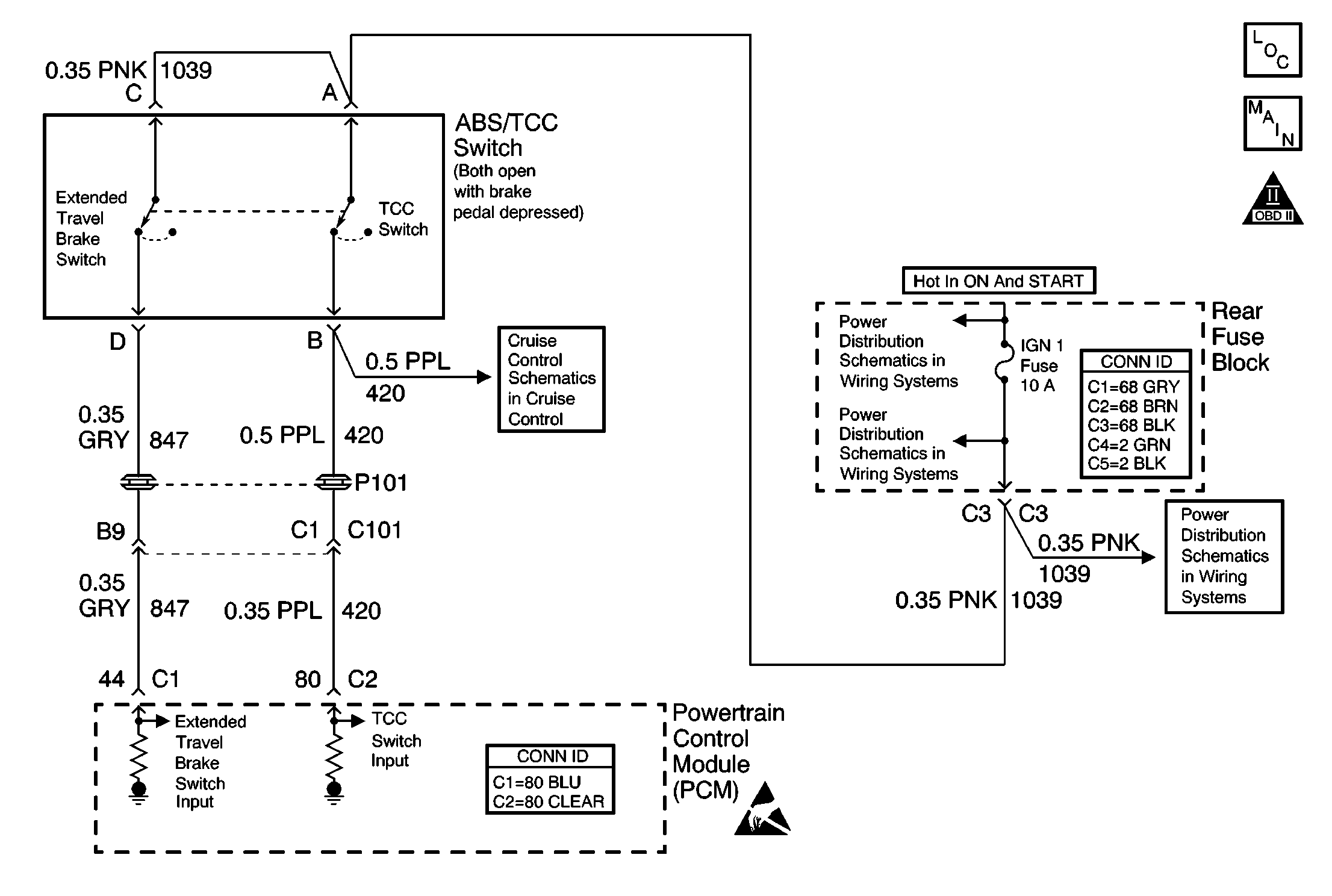
Circuit Description
This diagnostic test functions on the assumption that a sudden decrease in non-drive (rear) wheel speed must be caused by a brake application. Non-drive wheel speed and stop lamp switch status are supplied to the PCM through serial data from the electronic brake and traction control module (EBCM). If there is a 6 MPH or more decrease of non-drive wheel speed in 0.4 second and a transition of the TCC contacts at the TCC brake switch or stop lamp switch without a transition of the extended travel contacts of the TCC brake, DTC P1575 is set.
Conditions for Running the DTC
| • | DTCs P0703, P1574 and P1604 not set |
| • | The traction control and antilock brake systems have not failed |
| • | The traction control and antilock brake systems are not active. |
| • | The non-drive wheel speed goes above 20 MPH and then does not go below 4 MPH. |
Conditions for Setting the DTC
A 6 MPH or more decrease in non-drive wheel speed in 0.4 second and TCC brake switch or Stop/BTSI/Cruise brake switch indicating brakes applied and no transition is noticed in the extended travel contacts of the TCC brake switch indicating brakes applied.
Action Taken When the DTC Sets
| • | The PCM disables cruise control. |
| • | The PCM will set the extended travel brake switch status to not applied. |
| • | The malfunction indicator lamp (MIL) will not illuminate. |
| • | The PCM will command a message to be displayed. |
| • | The PCM may record operating conditions at the time the diagnostic fails. This information will be stored in the Failure Records. |
Conditions for Clearing the Message/DTC
| • | The PCM will turn the message OFF after one run and pass of the diagnostic test. |
| • | A History DTC will clear after forty consecutive warm-up cycles with no failures of any non-emission related diagnostic test. |
| • | A Last Test Failed (current) DTC will clear when the diagnostic runs and does not fail. |
| • | Use a scan tool to clear DTCs. |
| • | Interrupting PCM battery voltage may or may not clear DTCs. This practice is not recommended. Refer to Clearing Diagnostic Trouble Codes in Powertrain Control Module (PCM) . |
Diagnostic Aids
If the condition is intermittent, refer to Intermittent Conditions in Symptoms.
Step | Action | Values | Yes | No | ||||||
|---|---|---|---|---|---|---|---|---|---|---|
1 | Did you perform the Powertrain On-Board Diagnostic (OBD) System Check? | -- | ||||||||
2 |
Does the scan tool display indicate Released? | -- | ||||||||
3 | Depress the brake pedal approximately half-way. Does the scan tool display indicate Applied? | -- | Go to Diagnostic Aids | |||||||
4 | Disconnect the extended travel brake switch connector. Does the scan tool display indicate Applied? | -- | ||||||||
5 | Test for a short to voltage on the extended travel brake switch signal circuit. Did you find and correct the condition? | -- | ||||||||
6 | With a scan tool, observe the TCC brake switch display. Does the scan tool display indicate Released? | -- | ||||||||
7 |
Did you find and correct the condition? | -- | ||||||||
8 |
Does the scan tool indicate Released? | -- | ||||||||
9 | Inspect for poor connections at the TCC/extended travel brake switch. Did you find and correct the condition? | -- | ||||||||
10 | Test for the following conditions:
Did you find and correct the condition? | -- | ||||||||
11 | Inspect the Relay IGN 1 for an open fuse. Is the fuse open? | -- | ||||||||
12 |
Did you find and correct the condition? | -- | Go to Diagnostic Aids | |||||||
13 | Test for an open in the ignition feed circuit to the TCC/extended travel brake switch assembly. Did you find and correct the condition? | -- | ||||||||
14 | Test for proper TCC/extended travel brake switch adjustment. Did the switch require adjustment? | -- | ||||||||
15 | Replace the TCC/extended travel brake switch. Is the action complete? | -- | -- | |||||||
16 |
Important: The replacement PCM must be programmed. Replace the PCM. Refer to Powertrain Control Module Replacement/Programming . Is the action complete? | -- | -- | |||||||
17 |
Does the scan tool indicate that DTC P1575 passed? | -- | System OK |
